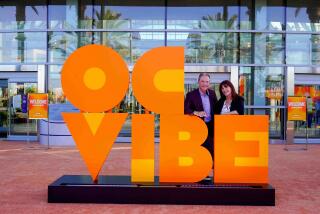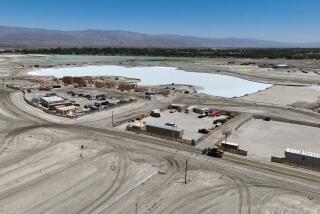NEWS ANALYSIS : Wherever Disney Nests, a Golden Egg Is Expected
- Share via
ANAHEIM — Entertainment industry analysts may be split over whether the Walt Disney Co. should build its next theme park in Anaheim or Long Beach, but they agree on this: Wherever it is, Disney will make plenty of money.
The Burbank-based entertainment giant has built successful parks in California, Florida and Japan, and industry experts expect the same kind of performance from the $2.9-billion Euro Disneyland when it opens in France next spring. While there are significant obstacles to clear before building either Port Disney on the Long Beach waterfront or WESTCOT Center and a new hotel complex in Anaheim, analysts said that if anyone can pull off either undertaking, Disney can.
“The name Disney is still magical,” said James Harmon, a partner with Management Resources, a Tustin consulting firm, “not only in terms of the product they produce and present to the public, but also the ability to manage and control their properties. Their record as an organization allows them to move ahead with programs and projects on huge scales, when perhaps another company couldn’t.”
Disney’s theme parks accounted for more than half of the company’s total revenue last year, generating a record $3 billion for fiscal 1990, up from $2.6 billion the year before.
This year, however, the theme-park business has been in a slump, with operating income for the quarter ended March 31 falling to $130.7 million; last year’s second-quarter figure was $194.5 million. The tourism business has been hurt by the recession and the Gulf War earlier this year.
Disney, however, is looking much further into the future.
In a carefully orchestrated series of press briefings Wednesday and Thursday, Disney officials unveiled conceptual plans for a $3-billion “second gate” development in what is now the Disneyland parking lot. The development would include WESTCOT Center--patterned after EPCOT Center in Orlando, Fla.--a new resort hotel complex, automobile garages and major transportation improvements that, together, the company hopes will make central Anaheim--well, attractive.
Company officials concede that the area surrounding Disneyland is a problem that they must address to boost attendance.
When the original park opened 36 years ago, “Disneyland was essentially the only development in what was a sea of orange groves,” said Kerry Hunnewell, vice president of development for Disney Development Co., the parent company’s real estate arm. “Today,” he said, “Disneyland is about the only green space in what is an area . . . marked by busy streets, surface parking lots, overhead power lines and rather confusing signage.”
Some analysts speculate that Anaheim’s urban blight, together with the constraints that accompany development, might make the Long Beach project Disney’s secret first choice--if, as promised, the company builds just one project at this time.
“I was more intrigued with the Long Beach project,” said one New York entertainment analyst who did not want to be identified. “There would be nothing like it in the world. EPCOT? It cost $1.2 billion when it opened, and the return on investment was just abysmal for the first three or four years.”
But as attendance grew and prices rose, EPCOT eventually became much more profitable, the analyst said. EPCOT stands for Experimental Prototype Community of Tomorrow, while WESTCOT is simply the term Disney has created for its proposed western parallel.
John Robinett, a consultant on theme parks hired by Long Beach to analyze the Port Disney proposal, agreed that Disney would be showing more imagination if it built what he called “a major fish attraction.”
“Long Beach is a very unique and compelling design, which I think the industry needs,” Robinett said. “Anaheim really presents some problems in terms of congestion. . . . And I think they’re (Disney officials) borrowing from other designs that have proven successful.”
In addition, Robinett said, Los Angeles--despite its beach culture--has not had an ocean-oriented theme park since Marineland shut down several years ago on the Palos Verdes Peninsula.
“Los Angeles is a major market,” he said. “It needs that sort of attraction, and it could support one. But no one else has bellied up to the bar.”
But Harmon of Management Resources said he saw distinct advantages for Disney choosing the Anaheim project.
“If they can work out the access and transportation issues with the city, it truly does add to an already-impressive mix of entertainment elements in Anaheim,” he said.
“Look at what else they’re talking about: enlarging the hotel base, the (planned) sports arena, you’ve got the stadium. You end up with a lot of critical mass, and that’s important in this industry. There’s great synergy there.”
City officials in Anaheim and Long Beach will spend the next few months trying to figure out just what they can offer Disney. And that, Salomon Bros. analyst Margo L. Vignola said, may be the precise effect the company sought this week in its less-than-detailed announcement.
“I think it’s designed to nudge along some of the authorities,” she said. “They have an agenda, and they’re sticking to it.”
Vignola recently returned from visiting Euro Disneyland, which, when it opens next year, will probably be the company’s focus for the near term.
Vignola said she was impressed by Disney’s ability to keep that project’s construction on schedule while maintaining tight quality control.
“It’s almost like they have a movie script and there are new scenes to film every day,” she said. “This is a well-managed, carefully managed company. They know what they’re doing.”
More to Read
The biggest entertainment stories
Get our big stories about Hollywood, film, television, music, arts, culture and more right in your inbox as soon as they publish.
You may occasionally receive promotional content from the Los Angeles Times.










